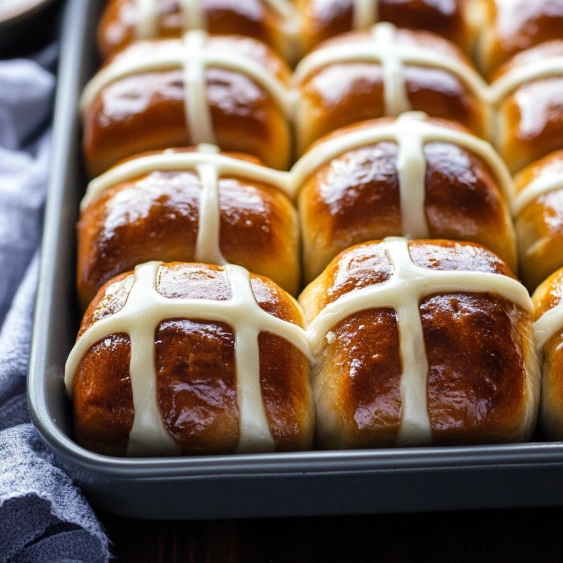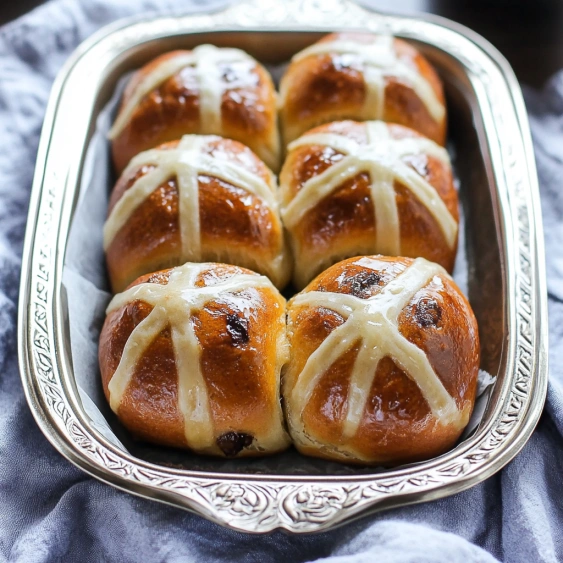 Pin it
Pin it
This soft and fluffy hot cross bun recipe transforms ordinary ingredients into an extraordinary Easter treat that will become your family's new tradition. The combination of warm spices, citrus zest, and rum-soaked currants creates buns that are tender on the inside with a golden exterior—perfect for celebrating spring mornings.
I developed this recipe after years of disappointing store-bought hot cross buns. My family now requests these every spring, and the house fills with an irresistible aroma that brings everyone to the kitchen before they're even out of the oven.
Ingredients
- Instant Yeast: activates quickly and ensures a reliable rise for perfectly fluffy buns
- Dried Currants: provide bursts of sweetness throughout the buns but raisins work wonderfully too
- Light Rum: plumps the dried fruit and adds subtle depth of flavor without being overpowering
- Pure Maple Syrup: brings natural sweetness and complexity that complements the spices
- Cardamom and Cinnamon: create that signature warm spice profile essential to traditional hot cross buns
- Citrus Zest: from both lemon and orange brightens the rich dough with vibrant freshness
- Mascarpone Cheese: makes for a luxurious cross topping that adds creamy richness to each bite
Step-by-Step Instructions
- Prepare the Yeast Mixture:
- Warm your milk to precisely 105-110°F before adding the yeast and a pinch of sugar. This temperature range is crucial as too hot will kill the yeast and too cool will slow activation. Allow it to sit for a full 15 minutes until actively bubbly and frothy which ensures your yeast is alive and ready to work.
- Plump the Dried Fruit:
- Soaking the currants or raisins in rum not only infuses them with flavor but also ensures they remain moist during baking. The quick microwave warming accelerates the absorption process. Be sure to drain thoroughly to prevent excess moisture in your dough.
- Combine Wet Ingredients:
- Whisk the eggs, cooled butter, vanilla, and maple syrup with the yeast mixture until completely incorporated. The butter must be cooled to prevent cooking the eggs or killing the yeast.
- Form the Dough:
- Add dry ingredients to wet and initially mix with a wooden spoon to prevent overworking. The hand mixing technique using the lift and fold method gently incorporates ingredients without tough results. This creates the perfectly tender texture that makes these buns special.
- Knead to Develop Structure:
- Kneading for the full 9-10 minutes develops the gluten structure that gives these buns their pillowy texture. The dough will transform from sticky to tacky which indicates proper gluten development. Resist adding too much flour which can make the buns dry.
- Allow First Rise:
- Place in a warm spot until doubled in size which typically takes 60-90 minutes depending on your kitchen temperature. This rise develops flavor and creates the airy texture that makes these buns irresistible.
- Shape Individual Buns:
- Dividing the dough into precisely equal portions ensures even baking. The rolling technique creates tension in the dough surface which results in a beautiful smooth top on each finished bun.
- Second Rise for Perfect Texture:
- Whether choosing the overnight or same-day method this second rise is critical for developing the perfect texture. The buns should be visibly puffy and touching one another before baking.
- Bake to Golden Perfection:
- The egg wash creates that signature glossy golden top. Using a thermometer ensures they're perfectly baked without guesswork. The interior temperature of 190-195°F guarantees they're cooked through while remaining moist.
- Add Signature Crosses:
- Pipe the mascarpone icing in clean straight lines after the buns have completely cooled to prevent melting. The thickness of the icing should be firm enough to hold its shape but soft enough to pipe smoothly.
 Pin it
Pin it
The orange zest in this recipe brings back memories of Easter mornings with my grandmother who always added citrus to her dough. She taught me that the zest contains the essential oils that give the most vibrant flavor, and I think of her every time that bright aroma fills my kitchen.
Troubleshooting Dough Consistency
Working with enriched dough can sometimes be tricky. If your dough feels too sticky during kneading, add flour just one tablespoon at a time. Too much flour will result in dry buns. The dough should feel tacky but not stick to your fingers when properly kneaded. Room temperature and humidity greatly affect dough consistency, so trust your touch more than exact measurements.
 Pin it
Pin it
Make It Your Own
These hot cross buns welcome customization to suit your taste preferences. Try substituting dried cranberries or chopped dried apricots for the currants. For chocolate lovers, add 1/3 cup mini chocolate chips to the dough. If you prefer a more pronounced spice profile, add 1/4 teaspoon of allspice or a pinch of cloves. The recipe remains balanced with these adjustments while allowing you to create a version that feels like your own family tradition.
Serving Suggestions
While traditionally served at breakfast on Good Friday or Easter Sunday, these versatile buns make a delightful accompaniment to afternoon tea. Split them horizontally and toast lightly for extra texture. For a decadent dessert, warm the buns, add a scoop of vanilla ice cream, and drizzle with caramel sauce. They also pair beautifully with sharp cheddar cheese for a sweet and savory combination that highlights the spices in the dough.
Historical Significance
Hot cross buns have a rich history dating back centuries. The cross symbolizes the crucifixion of Christ, making them traditional for Easter celebrations. In English tradition, hot cross buns baked on Good Friday were believed to never spoil throughout the coming year. Some sailors would take these buns on voyages to protect against shipwrecks. While our recipe adds modern touches like mascarpone icing, it honors this centuries-old tradition that connects us to bakers from generations past.
Frequently Asked Questions
- → Can I make these hot cross buns ahead of time?
Yes! The recipe includes an overnight option where you can shape the buns, place them in the refrigerator for 8-24 hours, then allow them to complete their second rise the next morning before baking.
- → What can I substitute for currants or raisins?
You can substitute dried cranberries, chopped dried apricots, or even chocolate chips if you prefer. For a traditional flavor, mixed candied citrus peel also works well.
- → Is there an alternative to the mascarpone icing?
Yes, the recipe mentions an alternative drizzle option in the notes. You could also use a simple powdered sugar glaze made with powdered sugar, milk or orange juice, and vanilla extract.
- → How do I know when the hot cross buns are fully baked?
The buns are done when a digital food thermometer inserted into them reads between 190-195°F (87-90°C) and the tops are golden brown. If they're browning too quickly, cover loosely with foil.
- → How should I store leftover hot cross buns?
Store unfrosted buns in an airtight container at room temperature for 1-2 days. With mascarpone icing, refrigerate and consume within 2 days. Buns can also be frozen (without icing) for up to 2 months—thaw at room temperature and warm slightly before serving.
- → What's the best way to warm leftover hot cross buns?
For the best texture, warm unfrosted buns in a 300°F (150°C) oven for 5-7 minutes. If frosted, microwave individual buns for about 10-15 seconds. You can also slice and toast them lightly.
